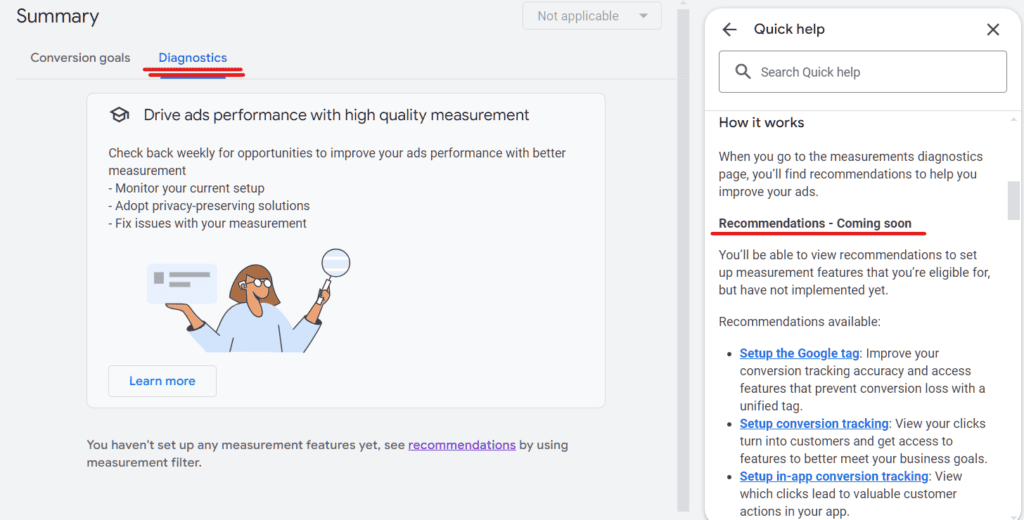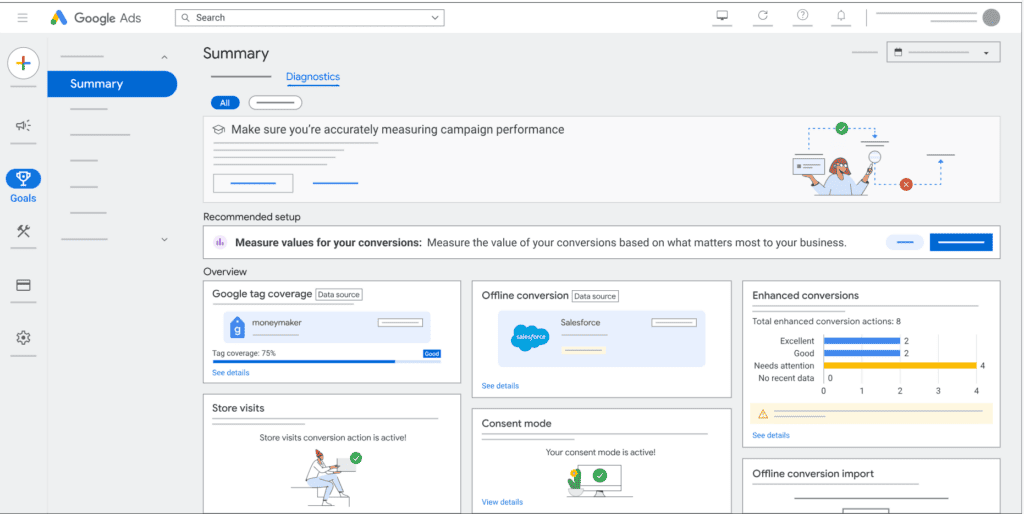Google Ads (formerly known as Google Adwords) is an online advertising platform developed by Google, where businesses and individuals can create and display ads to a global audience. Advertisers can choose to display their ads on Google search results pages, Google Maps, websites in the Google Display Network, and YouTube.
Advertisers use Google Ads to reach a specific audience, increase brand awareness, drive website traffic, and generate leads and sales. The platform allows advertisers to set a budget, select keywords, and target specific demographics, geographies, and interests. This provides a high level of control over who sees the ads and where they appear. Additionally, Google Ads also provides detailed analytics and performance metrics, which can help advertisers optimize their campaigns and measure their return on investment.
Google Ads is also useful because it allows you to measure the effectiveness of your ads on your business. You can track clicks, impressions, conversions, and revenue, giving you an idea of how your ads impact your business. It also allows you to test different ads and target audiences, which can help you find the best approach for your business.
Overall, Google Ads can be a valuable tool for businesses of all sizes to reach their target audience and drive growth. However, it’s important to note that creating and managing a successful campaign takes time and expertise.
- Google Ads Enhanced Conversions and First-Party Cookies
- Google introduces Account-Level Negative Keywords feature
- Google Ads Down For Advertisers, Google Confirms
- Google launches Ad Frequency Targeting for YouTube campaigns
- Performance Max campaign is not favored over Search campaigns
- Google shares 3 ways to create ads that will keep audiences engaged
- Google Ads introduces 3 new app measurement tools to grow your business
- Improve your ad’s performance with Google Smart Bidding
- Google launches Ad Frequency Targeting for YouTube campaigns
- Google Ads: Google will stop generating Similar Audiences Segments from all ad groups and campaigns
- Google Ads Announces Top 3 Priorities for 2022
- How to Audit Your Google Ads Account like a Pro
- Google Ads to Get More Transparent
- Australia Is the Latest Country to Consider Legislation to Limit Google’s Adtech Dominance
- Google Changes the Appearance of Its AdSense Policy Center and Adds New Features for Advertisers
- Do You Advertise Your Business on Google?
- YouTube and Display Are Now Supported by Google Ads Attribution Models
Google Ads Enhanced Conversions and First-Party Cookies
Google Ads’ enhanced conversions rely on first-party cookies from Google to track and measure conversions more accurately across devices and platforms. These cookies help in understanding user behavior and attributing conversions effectively, enhancing the overall conversion tracking capabilities within Google Ads.
Google suggests reviewing the Diagnostics report in Google Ads 72 hours after implementing enhanced conversions to ensure accuracy.
The diagnostic page is yet unavailable on my end, as shown in the screenshot below:

But here’s what you can expect to see upon viewing Google Ads’ diagnostic page:

Google introduces Account-Level Negative Keywords feature
This new feature improves brand safety and the effectiveness of your campaigns by allowing advertisers to specify keywords that are not relevant to their entire account. These negative keywords prevent Google from showing your ads to users who use search terms that match your negative keywords.
Source: https://www.searchenginejournal.com/new-google-ads-feature-account-level-negative-keywords/477926/
Google Ads Down For Advertisers, Google Confirms
Google Ads, the platform advertisers use to create and manage their advertising campaigns on Google, experienced an outage. The outage affected advertisers worldwide, preventing them from accessing their campaigns and making changes. Google confirmed the outage, stating that the issue had been resolved, and apologized for any inconvenience caused. The cause of the outage is still unknown, but Google is investigating to prevent future occurrences. Despite the inconvenience, many advertisers took the opportunity to take a break and reassess their campaigns.
Source: https://www.searchenginejournal.com/google-ads-down-for-advertisers-google-confirms/477080/
Google launches Ad Frequency Targeting for YouTube campaigns
We regularly update this post to give the latest news and important compilation of Google Ads’ best practices, trends, and tips.
Performance Max campaign is not favored over Search campaigns
This statement is according to Google Ads liaison Ginny Marvin, who added, “If you are running Search and PMax campaigns and the query isn’t identical to a keyword (or misspelling in your Search campaigns), then Ad Rank is used to determine which ad serves.”
Source: https://www.seroundtable.com/google-pmax-preferred-search-34704.html
Google shares 3 ways to create ads that will keep audiences engaged
2022 November 25
Users browse through various digital content from text to image to video. They often spend more time on content that gives them the most natural experiences. Use the following insights and creative innovations to make engaging ads that will help drive your growth:
- Come up with more tailored experiences for better engagement.
- Go for an asset-first approach to create a better impact.
- Use authentic and diverse representation to up your storytelling.
Source: https://blog.google/products/ads-commerce/engage-audience-in-content-driven-world/
Google Ads introduces 3 new app measurement tools to grow your business
2022 November 25
These new tools will help you assess cross-platform conversions, improve your campaign performance with privacy-focused measurement, and adjust to changes in platform standards on iOS and Android.
Source: https://blog.google/products/ads-commerce/app-measurement-strategies-business-growth/
Improve your ad’s performance with Google Smart Bidding
2022 November 25
By embracing Google’s AI-powered solutions, you can reach the right people with the right message at the right time. Find out how to save time and improve your ad performance with Smart Bidding.
Learn more here: https://support.google.com/google-ads/answer/6167140
Google launches Ad Frequency Targeting for YouTube campaigns
2022 November 16
The new feature will enable advertisers to control how often viewers can see their ads on YouTube, allowing them to optimize their ad’s reach and frequency.
Google Ads: Google will stop generating Similar Audiences Segments from all ad groups and campaigns
2022 November 11
This will be replaced by Optimized Targeting for video, display discovery, and performance campaigns, as well as Audience Expansion for brand campaigns.
Source: https://searchengineland.com/google-is-getting-rid-of-similar-audiences-segments-389234
Google Ads Announces Top 3 Priorities for 2022
2022 February 24Google Ads announced its top three priorities for 2022:
- automation,
- measurement, and
- privacy.
Source: https://blog.google/products/ads-commerce/growing-your-business-in-2022/
How to Audit Your Google Ads Account like a Pro
Here is an overview of what to expect when doing a step-by-step analysis to audit and help improve the profitability of your own Google Ads account.
Key takeaways:
- Why perform an audit?
- Ask the right questions
- Starting the Google Ads account audit
Source: https://searchengineland.com/how-to-audit-your-google-ads-account-like-a-pro-387486
Google Ads to Get More Transparent
Google announced that its online advertising will now include additional disclosures. This will allow web searchers to see who the advertiser is, why the ad was displayed to you, and previous ads the advertiser has run with Google, starting with the most recent.
The adjustments are part of Google’s more significant overhaul of its advertising business. A response to growing regulatory scrutiny and a broader tech industry movement toward technology that promotes transparency and consumer privacy.
Key takeaways:
- Google is expanding its advertising identity verification program, which required marketers to reveal personal information last year.
- Anyone can click on these new advertiser sites to learn more about the advertiser. They can also access a menu to examine all marketers’ advertising in the last 30 days.
- From a consumer’s standpoint, Google portrays this as a valuable tool. Pointing out how a consumer who sees a product for sale, such as a coat, could use the service to learn more about the business and its other products.
Australia Is the Latest Country to Consider Legislation to Limit Google’s Adtech Dominance
The Australian Competition and Consumer Commission is the latest to call for legal action to limit Google’s adtech monopoly.
It announced as it released the final findings of an investigation into competition concerns in the digital advertising industry. The Australian Competition and Consumer Commission (ACCC) says in the study that “for the benefit of businesses and consumers,” new legislative measures are required to address Google’s dominance and competition in the adtech sector.
Key takeaways:
- Regulators suggest that additional measures, such as data separation powers or data access limits, may be required to counteract Google’s dominance.
- The ACCC is worried that a lack of competition has resulted in higher advertising technology expenses.
- The ACCC also found that Google has used its position to favor its own services (aka self-preferencing) and shield them from competition, citing the example of how Google prevents rival adtech services from accessing ads on YouTube (which the watchdog claims gives Google’s adtech services an “important advantage”).
Read more: https://techcrunch.com/2021/09/28/australia-latest-to-eye-laws-to-curb-googles-adtech-dominance/
Google Changes the Appearance of Its AdSense Policy Center and Adds New Features for Advertisers
To guarantee that Ad Managers have a thorough picture of potential infractions that would prevent their ads from being displayed to searchers, Google introduced its Policy center for Ad Manager, AdMob, and AdSense. Publishers were also able to retain as much of their inventory as possible compliant with Google Ads standards thanks to the Policy Center.
Key takeaways:
- The account’s health status has been updated. The updated account health overview displays a zoomed-out view of the overall number of problematic sites and apps.
- More filtering options are available. Publishers can now use single or many columns to filter the tables, such as all issues reported on a specific date that is a ‘Must solve.’
- A new table view gives “Ad Manager publishers a more thorough picture of issues across their inventory,” in addition to the option to look at overall ad health and sort by specific issues.
Do You Advertise Your Business on Google?
Google answers some of the burning questions about FLoC. Advertisers are anxious to know about some concerns. Will website remarketing still be available for advertisers in 2022? Will the advertisers’ ability to report on in-market audiences, affinity audiences, or placements be impacted?
Source: https://www.searchenginejournal.com/google-answers-advertisers-floc-questions/399260/
YouTube and Display Are Now Supported by Google Ads Attribution Models
by Josh
Last Updated on August 12, 2021 by Josh
People may interact with many ads from the same brand while making purchasing decisions. You may pick how much credit each ad interaction receives for your conversions using attribution models. This would allow you to focus your resources on the media that has the most impact.
To support YouTube and Display advertisements, all Google Ads non-last click models have been improved, including data-driven attribution. The data-driven attribution strategy measures engaged views from YouTube in addition to clicks.
Key takeaways:
- You can compare your cost per conversion and return on ad spend by changing your attribution model.
- For search marketers, attribution is a thorny problem that is only getting muddier as more web focuses on privacy.
- The ability to model attribution journeys through YouTube and Display will aid marketers in determining which channels to spend in and which channels might benefit from a different approach.
Read more: https://searchengineland.com/google-ads-attribution-models-now-support-youtube-and-display-351068

